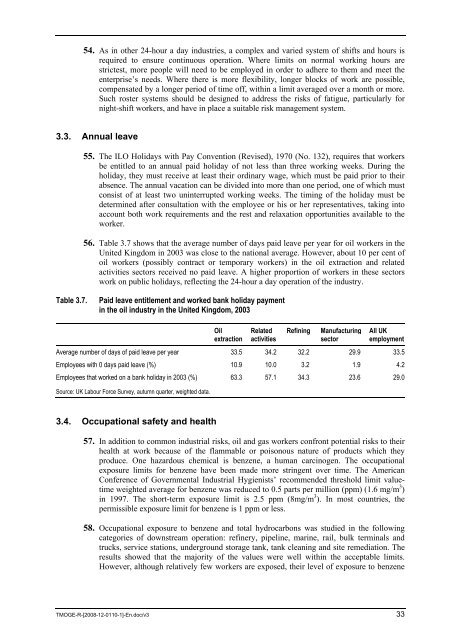wcms_161662
wcms_161662
wcms_161662
You also want an ePaper? Increase the reach of your titles
YUMPU automatically turns print PDFs into web optimized ePapers that Google loves.
54. As in other 24-hour a day industries, a complex and varied system of shifts and hours is<br />
required to ensure continuous operation. Where limits on normal working hours are<br />
strictest, more people will need to be employed in order to adhere to them and meet the<br />
enterprise’s needs. Where there is more flexibility, longer blocks of work are possible,<br />
compensated by a longer period of time off, within a limit averaged over a month or more.<br />
Such roster systems should be designed to address the risks of fatigue, particularly for<br />
night-shift workers, and have in place a suitable risk management system.<br />
3.3. Annual leave<br />
55. The ILO Holidays with Pay Convention (Revised), 1970 (No. 132), requires that workers<br />
be entitled to an annual paid holiday of not less than three working weeks. During the<br />
holiday, they must receive at least their ordinary wage, which must be paid prior to their<br />
absence. The annual vacation can be divided into more than one period, one of which must<br />
consist of at least two uninterrupted working weeks. The timing of the holiday must be<br />
determined after consultation with the employee or his or her representatives, taking into<br />
account both work requirements and the rest and relaxation opportunities available to the<br />
worker.<br />
56. Table 3.7 shows that the average number of days paid leave per year for oil workers in the<br />
United Kingdom in 2003 was close to the national average. However, about 10 per cent of<br />
oil workers (possibly contract or temporary workers) in the oil extraction and related<br />
activities sectors received no paid leave. A higher proportion of workers in these sectors<br />
work on public holidays, reflecting the 24-hour a day operation of the industry.<br />
Table 3.7. Paid leave entitlement and worked bank holiday payment<br />
in the oil industry in the United Kingdom, 2003<br />
Oil<br />
extraction<br />
Related<br />
activities<br />
Refining Manufacturing<br />
sector<br />
All UK<br />
employment<br />
Average number of days of paid leave per year 33.5 34.2 32.2 29.9 33.5<br />
Employees with 0 days paid leave (%) 10.9 10.0 3.2 1.9 4.2<br />
Employees that worked on a bank holiday in 2003 (%) 63.3 57.1 34.3 23.6 29.0<br />
Source: UK Labour Force Survey, autumn quarter, weighted data.<br />
3.4. Occupational safety and health<br />
57. In addition to common industrial risks, oil and gas workers confront potential risks to their<br />
health at work because of the flammable or poisonous nature of products which they<br />
produce. One hazardous chemical is benzene, a human carcinogen. The occupational<br />
exposure limits for benzene have been made more stringent over time. The American<br />
Conference of Governmental Industrial Hygienists’ recommended threshold limit valuetime<br />
weighted average for benzene was reduced to 0.5 parts per million (ppm) (1.6 mg/m 3 )<br />
in 1997. The short-term exposure limit is 2.5 ppm (8mg/m 3 ). In most countries, the<br />
permissible exposure limit for benzene is 1 ppm or less.<br />
58. Occupational exposure to benzene and total hydrocarbons was studied in the following<br />
categories of downstream operation: refinery, pipeline, marine, rail, bulk terminals and<br />
trucks, service stations, underground storage tank, tank cleaning and site remediation. The<br />
results showed that the majority of the values were well within the acceptable limits.<br />
However, although relatively few workers are exposed, their level of exposure to benzene<br />
TMOGE-R-[2008-12-0110-1]-En.doc/v3 33














